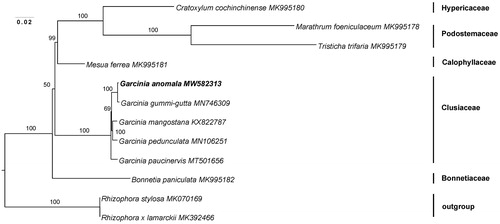Abstract
Garcinia anomala Planch. & Triana is an evergreen tree classified to the genus Garcinia in the family Clusiaceae. Here we report and characterize the complete chloroplast genome sequence of G. anomala and its phylogenetic relationship was investigated. The chloroplast genome is 156,774 bp in length and has a typical quadripartite chromosomal structure. The genome is divided into a pair of inverted repeat regions (IR) of 27,053 bp, one small single-copy (SSC) region of 17,082 bp and a large single copy (LSC) region of 85,586 bp. The overall GC content is 36.1%. A total of 130 functional genes were annotated, including 85 protein-coding, 37 tRNA and 8 rRNA genes. The phylogenetic analysis of G. anomala fully resolved it in a clade with four Garcinia taxa within clusioid clade of the Malpighiales.
Garcinia anomala (heterotypic synonym Garcinia bracteata C. Y. Wu ex Y. H. Li 1981), is an understory tree classified in the genus Garcinia. The species is distributed in Yunnan, Guangxi Province in China and north of Indo-China (Planchon and Triana Citation1860; Wang et al. Citation2017). In the Dai People culture, its fruit is considered edible and has high economic and medicinal value (Liu et al. Citation2016). Xanthones, which are known as a unique class of biologically active compounds, are extracted from G. anomala and function as antioxidants, antimicrobial, antiviral, cytotoxic, antiinflammation and serve as a broad-spectrum of anti-tumor activities (Niu et al. Citation2017; Qing et al. Citation2020). As an important medicinal and horticultural plant, there is a total lack of phylogenetic and genomic data. To better understand its unique chemical components and important pharmacological properties, here the complete chloroplast genome of G. anomala is reported.
Fresh leaves of G. anomala was collected from the Xishuangbanna Tropical Botanical Garden (XTBG), Chinese Academy of Sciences, Yunnan Province (Location: E 101.2546, N 21.9263, 564 m). The voucher was deposited at the Herbarium of XTBG (http://hitbc.xtbg.ac.cn, Jianwu Li and [email protected]) under the voucher number SY6021. Total genomic DNA was extracted using the CTAB method (Doyle and Dickson Citation1987). The complete chloroplast genome was sequenced following Zhang et al. (Zhang et al. Citation2016) and their 15 universal primer pairs were used to perform long-range PCR for next-generation sequencing. The contigs were aligned using the publicly available plastid genome of G. mangostana (KX822787) and annotated in Geneious 8.1.9.
The plastome of G. anomala (MW582313) has a length of 156,774 bp. There are 130 genes in number, including 85 protein-coding, 37 tRNA and 8 rRNA genes. The complete chloroplast genome is comprised of a pair of inverted repeat (IR) regions (27,053 bp) that are separated by a large single copy region (LSC) with a length of 85,586 bp, and a small single copy region (SSC) with a length of 17,082 bp. The total GC content of the chloroplast genome is 36.1%, of which the GC content for the IR regions is 42.1%, the LSC (33.5%) and SSC (30.3%) regions.
In order to confirm the evolutionary relationship of G. anomala, a maximum likelihood (ML) phylogenetic tree was inferred based on 78 plastid encoded protein genes, of which 9 species from the order Malpighiales, including 4 species of genus Garcinia, and 2 species of Rhizophora that served as the outgroups (). The 12 sequences were aligned were aligned using the default settings with the MAFFT version 7 (Katoh et al. Citation2019). The maximum likelihood phylogenetic analyses were performed based on GTR + F + I + G4 model in the iqtree version 1.6.7, with 1,000 bootstrap replicates (Lam-Tung et al. Citation2015). The analysis shows that G. anomala is fully resolved in a clade containing four other Garcinia taxa, and these findings are consistent with former studies (Jin et al. Citation2020), the clusioid clade of the Malpighiales, which is comprised of five families, is also supported. The complete chloroplast genome sequence of G. anomala will be useful for development of further phylogenetic analysis and secondary metabolite studies.
Disclosure statement
The author is responsible for the content and no potential conflict of interest among the authors.
Data availability statement
The genome sequence data that support the findings of this study are openly available in GenBank of NCBI at [https://www.ncbi.nlm.nih.gov] (https://www.ncbi.nlm.nih.gov/) under the accession no. MW582313. The associated BioProject, SRA, and BioSample numbers are PRJNA726157, SRX10710705, and SAMN18921341 respectively.
Additional information
Funding
References
- Liu B, Zhang XB, Bussmann RW, Hart HR, Li P, Bai Y, Long CL. 2016. Garcinia in Southern China: ethnobotany, management, and niche modeling. Econ Bot. 70(4):416–430.
- Doyle JJ, Dickson EE. 1987. Preservation of plant samples for DNA restriction endonuclease analysis. Taxon. 36(4):715–722.
- Jin DM, Jin JJ, Yi TS. 2020. Plastome structural conservation and evolution in the clusioid clade of malpighiales. Sci Rep. 10(1):9091.
- Katoh K, Rozewicki J, Yamada KD. 2019. MAFFT online service: multiple sequence alignment, interactive sequence choice and visualization. Brief Bioinform. 20(4):1160–1166.
- Lam-Tung N, Schmidt HA, Arndt VH, Quang MB. 2015. IQ-TREE: a fast and effective stochastic algorithm for estimating maximum-likelihood phylogenies. Mol Biol Evol. 32(1):268–274.
- Niu S-L, Li D-H, Wang Y-T, Wang K-B, Lin B, Jing Y-K, Hua H-M, Bai J, Li Z-L. 2017. Neobraclactones A-C, three unprecedented chaise longue-shaped xanthones from Garcinia bracteata. Org Biomol Chem. 15(22):4901–4906.
- Planchon JE, Triana J. 1860. Annales des Sciences Naturelles[M/OL]. Victor Masson et Fils, Paris, 329–331. https://www.biodiversitylibrary.org/page/41586414.
- Qing X, Yu C, Yin H, Teng H, Qin R, Liu H, et al. 2020. Prenylated xanthones and benzophenones from the fruits of Garcinia bracteata and their potential antiproliferative and anti-inflammatory activities. Bioorg Chem. 104:104339.
- Wang L, Xie Y, Zhang Z. 2017. The identification of Garcinia anomala (Clusiaceae). Phytotaxa. 327(2):167.
- Zhang T, Zeng CX, Yang JB, Li HT, Li DZ. 2016. Fifteen novel universal primer pairs for sequencing whole chloroplast genomes and a primer pair for nuclear ribosomal DNAs. J Syst Evol. 54(3):219–227.

